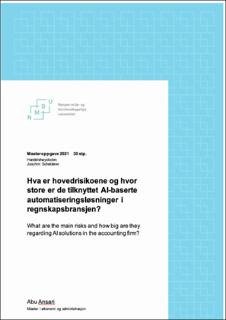| dc.contributor.advisor | Scholderer, Joachim | |
| dc.contributor.author | Ansari, Abu Talha Zareef | |
| dc.date.accessioned | 2021-11-02T11:52:34Z | |
| dc.date.available | 2021-11-02T11:52:34Z | |
| dc.date.issued | 2021 | |
| dc.identifier.uri | https://hdl.handle.net/11250/2827267 | |
| dc.description.abstract | Hensikten med denne oppgaven er å se på hovedrisikoene og hvor store de er tilknyttet AI-baserte automatiseringsløsninger i regnskapsbransjen. For å besvare denne problemstillingen valgte jeg både kvalitativ- og kvantitativ forskningsdesign. I den kvalitative tilnærmingen ble det gjennomført intervjuer med fire informanter hos svært anerkjente bedrifter. I den andre delen av oppgaven ble det utført en risikoanalyse, mer presist en Monte Carlo simulasjon.
Basert på den utvalgte teorien har AI allerede kommet veldig langt i regnskapsbransjen. Ved bruk av maskinlæring har bedrifter fått hjelpende en hånd til de rutinemessige oppgavene slik at de får muligheten til å fokusere på andre mer kompliserte oppgaver. Informantene til denne oppgaven delte samme syn som teorien, men påstod at kompetanse innen IT og programmering vil være svært viktig for fremtidig regnskapsførere. I tillegg dras det paralleller mellom manglende kompetanse og tillit til maskinene. Noen av informantene påstod at de som ikke forstår seg på den nye teknologien og AI-systemene har større sjanse for mistillit til maskinene.
Risikoanalysen er delt inn i tre scenarier med manuell fakturahåndtering (scenario 1), delvis automatisert uten behandlingsfeil (scenario 2) og delvis automatisert med behandlingsfeil (scenario 3). Det mest realistiske scenarioet er scenario 3 fordi ingen systemer eller maskiner er feilfrie, og man ønsker å fokusere på komponentene innen fakturahåndtering som skaper mest usikkerhet. Utover i oppgaven vil leserne få muligheten til å se en sammenligning av de ulike scenariene, og hvor gevinsten egentlig ligger. | en_US |
| dc.description.abstract | The purpose of this task is to look at the main risks and how big they are associated with AIbased automation solutions in the accounting firm. To answer this problem, I chose both qualitative and quantitative research design. In the qualitative approach, interviews were conducted with four informants at highly and respectable companies. In the second part of the task, a risk analysis was performed called Monte Carlo simulation.
Based on the selected theory, AI has already come a long way in the accounting firm. When using machine learning in the less complicated accounting tasks, companies now have the opportunity to focus on more complicated tasks. The informants shared the exact same view as the theory but claimed that competence and skill in IT and programming will be a key factor for future accountants. In addition, they claimed that it is a correlation between lack of competence and trust issues with AI. Some of informants argued that those who do not understand new technology and AI systems have a greater chance of trust issues with the machines.
The risk analysis is divided into three scenarios with scenario 1 being traditional invoice management, scenario 2 partly automated processes without errors and scenario 3 being partly automated processes with errors. The most realistic scenario is scenario 3 because no systems or machines are free for error, and as you will see, ideally you want to focus on the variables within invoice management that create the most uncertainty. Throughout the thesis, readers will have the opportunity to see a comparison of the three scenarios and understand if there is a profit by automating accounting tasks. | en_US |
| dc.language.iso | nob | en_US |
| dc.publisher | Norwegian University of Life Sciences, Ås | en_US |
| dc.rights | Attribution-NonCommercial-NoDerivatives 4.0 Internasjonal | * |
| dc.rights.uri | http://creativecommons.org/licenses/by-nc-nd/4.0/deed.no | * |
| dc.title | Hva er hovedrisikoene og hvor store er de tilknyttet AI-baserte automatiseringsløsninger i regnskapsbransjen? | en_US |
| dc.title.alternative | What are the main risks and big are they regarding AI solutions in the accounting firm? | en_US |
| dc.type | Master thesis | en_US |
| dc.source.pagenumber | 53 | en_US |
| dc.description.localcode | M-ØA | en_US |

